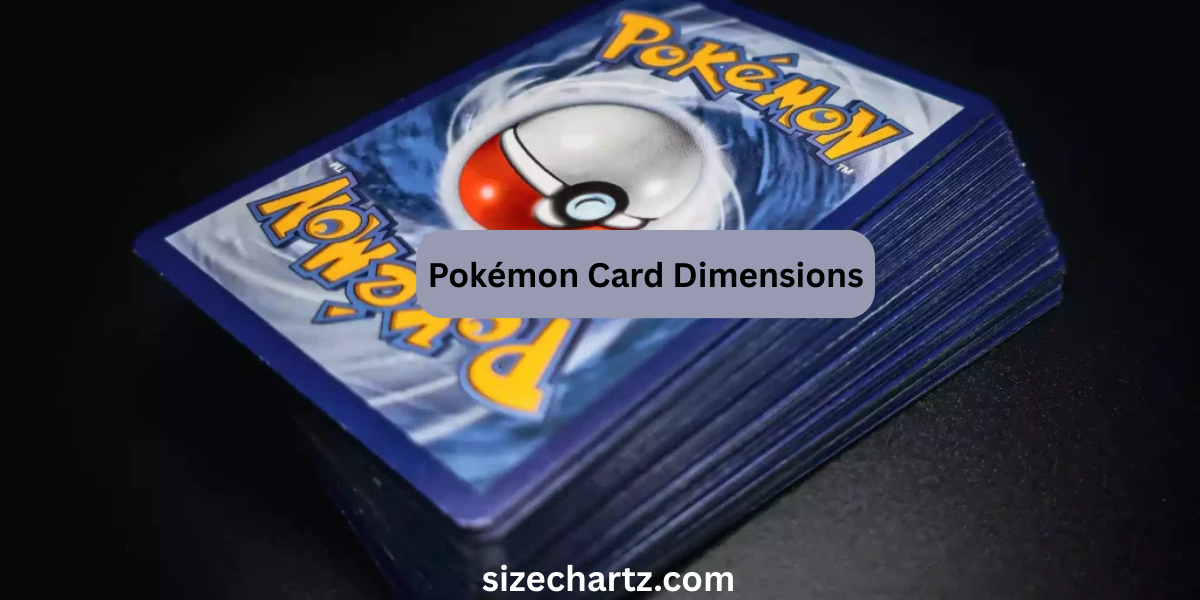Have you ever picked up a Pokémon card and wondered why it feels just right in your hand? Or maybe you’ve been shopping for protective sleeves and realized there are dozens of options—some too tight, some too loose, some labeled “standard,” others “Japanese.” If you’ve ever been confused by Pokémon card dimensions, you’re not alone.
The truth is, card size is one of the most overlooked details in the Pokémon Trading Card Game (TCG), yet it affects everything: collecting, storing, grading, playing, and even the value of your cards. Whether you’re a casual collector, a competitive player, or someone just starting out, understanding Pokémon card dimensions helps you make smarter choices, avoid costly mistakes, and keep your collection in top condition.
In this complete guide, we’ll break down everything you need to know about Pokémon card dimensions—from exact measurements and comparisons with other trading cards to sleeve sizes, storage tips, grading standards, and even some surprising facts you probably didn’t know. By the end, you’ll have a clear, practical understanding that solves all your card-sizing questions once and for all.
What Are the Standard Pokémon Card Dimensions?
Let’s start with the basics. Pokémon cards follow a consistent standard size, just like many other trading card games.
- Width: 2.5 inches (63 mm)
- Height: 3.5 inches (88 mm)
- Thickness: Around 0.012 inches (0.3 mm)
This size is the same as a standard playing card or a Magic: The Gathering card, which is why you’ll often see sleeves and binders marketed as “standard size” working perfectly for Pokémon cards.
Why These Dimensions?
When Pokémon cards were first introduced in Japan in 1996, their design closely followed the established trading card template set by other games like Magic: The Gathering. The 2.5 × 3.5 inch size strikes a balance: big enough for detailed artwork, but small enough to shuffle, stack, and carry easily.
Japanese vs. International Pokémon Card Sizes
One of the most common questions collectors ask is whether Japanese Pokémon cards are a different size from English cards.
Here’s the answer:
- Japanese Pokémon cards are slightly smaller than English cards.
- They measure about 63 × 88 mm for international cards, while Japanese cards come in around 59 × 86 mm.
It’s not a huge difference, but it matters when you’re buying sleeves. A sleeve that fits snugly on a Japanese card may feel too tight or not fit at all on an English card. This is why you’ll often see two types of sleeves marketed: “Standard size” (for English cards) and “Japanese size” (for smaller Japanese cards).
Comparing Pokémon Card Dimensions to Other Popular Trading Cards
Understanding Pokémon card dimensions is easier when you compare them to other TCGs:
- Magic: The Gathering (MTG): Same size as Pokémon (63 × 88 mm).
- Yu-Gi-Oh!: Slightly smaller (59 × 86 mm), very close to Japanese Pokémon cards.
- Baseball/Collectible Sports Cards: Same standard size (63 × 88 mm).
This overlap is great news if you collect multiple card games—you can often reuse storage solutions. But when it comes to sleeves, even a millimeter makes a difference.
The Role of Pokémon Card Dimensions in Gameplay
If you’re playing casually with friends, you might not think twice about card size. But in tournaments and official gameplay, dimensions matter more than you’d expect.
- Shuffling consistency: Standard card dimensions make shuffling smoother and fairer.
- Sleeve rules: Tournament rules often require sleeved cards for protection. Sleeves must be uniform and fit the card size exactly to prevent “marking” (where a damaged or oversized sleeve gives away which card is which).
- Deck building: The 60-card standard deck feels natural and manageable partly because of the card dimensions. Imagine handling 60 oversized cards—it wouldn’t work.
Pokémon Card Thickness: Does It Matter?
Most Pokémon cards are around 0.3 mm thick, but this can vary slightly depending on:
- Holofoil layers (holographic cards are a bit thicker)
- Special promos (sometimes printed differently)
- Counterfeit cards (fakes are often thinner or thicker than standard)
Thickness plays a role in:
- Sleeve fit
- Binder storage capacity
- PSA/CGC grading (authenticity is partly confirmed by exact weight and thickness)
Pokémon Card Dimensions and Sleeves
If you care about protecting your cards (and you should), sleeves are non-negotiable. But with so many options, knowing the right size is critical.
Sleeve Sizes for Pokémon Cards
- Standard Pokémon cards (English): Use “standard size” sleeves (66 × 91 mm).
- Japanese Pokémon cards: Use “Japanese size” sleeves (62 × 89 mm).
Types of Sleeves
- Penny sleeves: Thin, inexpensive, basic protection.
- Deck sleeves: Durable, often with matte/shuffle-friendly backs.
- Perfect fit (inner sleeves): Ultra-snug sleeves that fit inside standard sleeves for double protection.
- Collector sleeves: Decorative artwork sleeves, popular among casual players.
Pro tip: If you’re sleeving valuable cards for storage, always use inner sleeves plus an outer sleeve (“double sleeving”).
Pokémon Card Dimensions and Grading
Professional grading companies like PSA, Beckett, and CGC rely on Pokémon card dimensions when authenticating and grading cards.
- Exact size and thickness: If a card is even slightly off, it may be flagged as counterfeit.
- Centering and borders: Graders measure whether artwork and borders align correctly. Because dimensions are standardized, even small printing errors stand out.
- Fitting in cases: Grading slabs are built for standard Pokémon card size, so accurate dimensions ensure a snug, tamper-proof fit.
Misconceptions About Pokémon Card Dimensions
- “All Pokémon cards are the same size.”
False—Japanese cards are smaller. - “Sleeves are universal.”
Not true. Yu-Gi-Oh! sleeves don’t fit English Pokémon cards. - “Thickness doesn’t matter.”
Actually, it does. Some fakes are detectable because they’re too thick or too thin.
Mistakes to Avoid When Dealing With Pokémon Card Sizes
- Buying the wrong sleeves (common for beginners).
- Overstuffing binders (causes warping and edge damage).
- Not checking counterfeit dimensions (fakes often “feel” wrong in size and weight).
- Storing cards without considering thickness (holofoil and textured cards need slightly looser storage).
Industry Trends: Pokémon Card Design and Dimensions
Pokémon has largely kept its card dimensions the same since the 1990s. Why? Because consistency protects the integrity of the game.
However, special releases sometimes break the mold:
- Oversized jumbo cards (like those from promo boxes, typically 5 × 7 inches or larger).
- Mini cards (rare promotional releases in smaller-than-standard sizes).
- Alternative printing techniques (thicker, textured cards for premium feel).
These outliers are fun collectibles but aren’t playable in tournaments.
Real-Life Examples: Where Dimensions Make a Difference
- A new collector buys Yu-Gi-Oh! sleeves for Pokémon cards—realizes too late they’re too small.
- A competitive player invests in double-sleeving with precise measurements to pass tournament deck checks.
- A grader spots a counterfeit because it’s 1 mm smaller than the standard size.
Each scenario shows how much one small detail—dimensions—can matter.
Frequently Asked Questions About Pokémon Card Dimensions
1. Are Pokémon cards the same size as baseball cards?
Yes, English Pokémon cards are the same size as standard sports trading cards (2.5 × 3.5 inches).
2. Do Japanese Pokémon cards fit in English Pokémon sleeves?
They technically fit, but they’ll feel loose. For the best fit, use Japanese-sized sleeves.
3. How big are jumbo Pokémon cards?
Most jumbo cards measure about 5 × 7 inches, though some older promos have unique sizes.
4. Can card thickness vary between sets?
Yes, holofoil and textured cards are slightly thicker than common cards.
5. Are fake Pokémon cards always the wrong size?
Not always, but many are. Counterfeiters sometimes get dimensions wrong, so measuring can help spot fakes.
6. What sleeve size should I buy for Pokémon cards?
For English cards, buy standard size (66 × 91 mm). For Japanese cards, buy Japanese size (62 × 89 mm).
7. Do graded cards have the same dimensions as raw cards?
The cards themselves do, but grading slabs are much larger since they include protective casing.
8. Why do jumbo cards exist if they’re unplayable?
They’re designed as collector’s items, often included as fun promos in special boxes.
Final Thoughts
At first glance, Pokémon card dimensions might seem like a trivial detail. But as we’ve seen, the exact size and thickness of your cards affect everything from gameplay and grading to storage and collecting.
When you know the correct dimensions, you:
- Buy the right sleeves and binders.
- Protect your cards from damage.
- Spot counterfeits more easily.
- Preserve your collection’s value.
So the next time you hold a Pokémon card, remember—it’s not just a piece of cardboard. Its carefully designed dimensions are what make the Pokémon TCG a smooth, fair, and enjoyable game for millions around the world.
Whether you’re protecting your first holofoil or building a high-end graded collection, getting the dimensions right is one of the simplest but most powerful steps you can take.


Leave a Reply